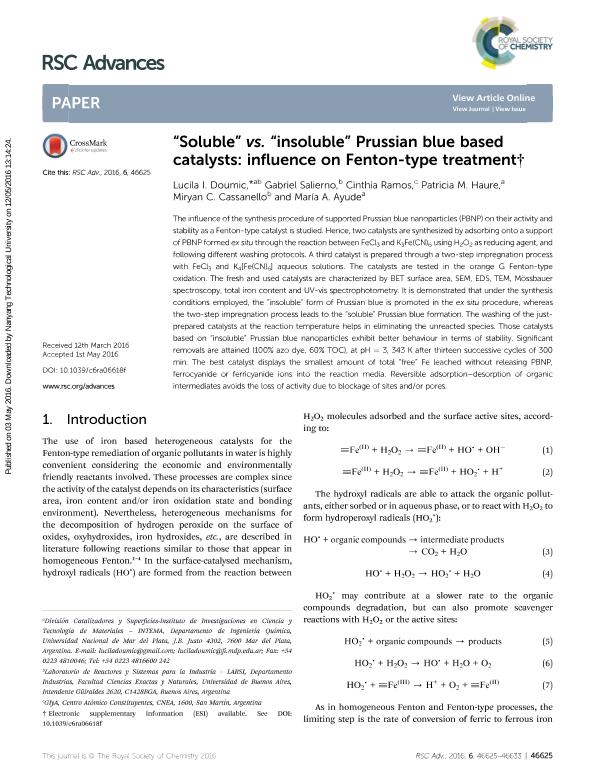Artículo
“Soluble” vs. “insoluble” Prussian blue based catalysts: influence on Fenton-type treatment
Doumic, Lucila Inés ; Salierno, Gabriel Leonardo
; Salierno, Gabriel Leonardo ; Ramos, Cinthia Paula
; Ramos, Cinthia Paula ; Haure, Patricia Monica
; Haure, Patricia Monica ; Cassanello Fernandez, Miryam Celeste
; Cassanello Fernandez, Miryam Celeste ; Ayude, María Alejandra
; Ayude, María Alejandra
 ; Salierno, Gabriel Leonardo
; Salierno, Gabriel Leonardo ; Ramos, Cinthia Paula
; Ramos, Cinthia Paula ; Haure, Patricia Monica
; Haure, Patricia Monica ; Cassanello Fernandez, Miryam Celeste
; Cassanello Fernandez, Miryam Celeste ; Ayude, María Alejandra
; Ayude, María Alejandra
Fecha de publicación:
05/2016
Editorial:
Royal Society of Chemistry
Revista:
RSC Advances
ISSN:
2046-2069
Idioma:
Inglés
Tipo de recurso:
Artículo publicado
Clasificación temática:
Resumen
The influence of the synthesis procedure of supported Prussian blue nanoparticles (PBNP) on their activity and stability as a Fenton-type catalyst is studied. Hence, two catalysts are synthesized by adsorbing onto a support of PBNP formed ex situ through the reaction between FeCl3 and K3Fe(CN)6 using H2O2 as reducing agent, and following different washing protocols. A third catalyst is prepared through a two-step impregnation process with FeCl3 and K4[Fe(CN)6] aqueous solutions. The catalysts are tested in the orange G Fenton-type oxidation. The fresh and used catalysts are characterized by BET surface area, SEM, EDS, TEM, Mössbauer spectroscopy, total iron content and UV-vis spectrophotometry. It is demonstrated that under the synthesis conditions employed, the “insoluble” form of Prussian blue is promoted in the ex situ procedure, whereas the two-step impregnation process leads to the “soluble” Prussian blue formation. The washing of the just-prepared catalysts at the reaction temperature helps in eliminating the unreacted species. Those catalysts based on “insoluble” Prussian blue nanoparticles exhibit better behaviour in terms of stability. Significant removals are attained (100% azo dye, 60% TOC), at pH = 3, 343 K after thirteen successive cycles of 300 min. The best catalyst displays the smallest amount of total “free” Fe leached without releasing PBNP, ferrocyanide or ferricyanide ions into the reaction media. Reversible adsorption–desorption of organic intermediates avoids the loss of activity due to blockage of sites and/or pores.
Palabras clave:
Prussian Blue
,
Fenton-Like
,
Orange G
Archivos asociados
Licencia
Identificadores
Colecciones
Articulos(INTEMA)
Articulos de INST.DE INV.EN CIENCIA Y TECNOL.MATERIALES (I)
Articulos de INST.DE INV.EN CIENCIA Y TECNOL.MATERIALES (I)
Articulos(OCA CIUDAD UNIVERSITARIA)
Articulos de OFICINA DE COORDINACION ADMINISTRATIVA CIUDAD UNIVERSITARIA
Articulos de OFICINA DE COORDINACION ADMINISTRATIVA CIUDAD UNIVERSITARIA
Articulos(SEDE CENTRAL)
Articulos de SEDE CENTRAL
Articulos de SEDE CENTRAL
Citación
Doumic, Lucila Inés; Salierno, Gabriel Leonardo; Ramos, Cinthia Paula; Haure, Patricia Monica; Cassanello Fernandez, Miryam Celeste; et al.; “Soluble” vs. “insoluble” Prussian blue based catalysts: influence on Fenton-type treatment; Royal Society of Chemistry; RSC Advances; 6; 52; 5-2016; 46625-46633
Compartir
Altmétricas



